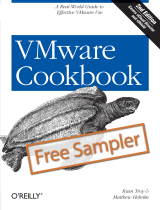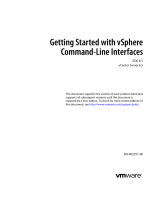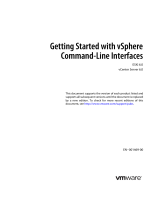Page is loading ...

VMware ESXi 5.5 – 6.5 Host Configuration
Rapid EqualLogic Configuration Series
Implementation Guide
September 2017

2 VMware ESXi 5.5 – 6.5 Host Configuration | Rapid EqualLogic Configuration Series | Implementation Guide | REC4004
Revisions
Date
Status
April 2012
Initial release
September 2012
Updates for VMware
®
ESXi™ 5.1 and MEM 1.1.1
October 2012
Correction in section 2: “Enable flow control on iSCSI NICs”
December 2012
Added info for connecting to iSCSI volumes
April 2013
Added info for setting Software Initiator LoginTimeout parameter
December 2013
Added info for ESXi 5.5, MEM 1.2, and Dell™ PS Series firmware version 7
July 2015
Added info for ESXi 6.0, MEM 1.3, and Dell PS Series firmware version 7.1.x
Removed info for ESXi 4.x and 5.0
September 2017
Added info for ESXi 6.5 and Dell PS Series firmware version 9.x
Removed info for ESXi 5.1
Document conventions
Format
Description
Example
Bold
User input: menus,
tabs, buttons
In the Console tab, select Troubleshooting and click OK.
[Keystroke]
Keystroke
Verify the results and press [Enter].
[Key1]+[Key2]
Combination
keystroke
Press [Alt]+[F1] to open the local console.
Screen text
Console or
command-line text
Type the command: setup.pl
Italic screen
text
Placeholder or
variable
Type: server=host IP address
The information in this publication is provided “as is.” Dell Inc. makes no representations or warranties of any kind with
respect to the information in this publication, and specifically disclaims implied warranties of merchantability or fitness for
a particular purpose.
Use, copying, and distribution of any software described in this publication requires an applicable software license.
© 2012 - 2017 Dell Inc. or its subsidiaries. All Rights Reserved. Dell, EMC, Dell EMC and other trademarks are
trademarks of Dell Inc. or its subsidiaries. Other trademarks may be trademarks of their respective owners.
Dell believes the information in this document is accurate as of its publication date. The information is subject to change
without notice.

3 VMware ESXi 5.5 – 6.5 Host Configuration | Rapid EqualLogic Configuration Series | Implementation Guide | REC4004
1 Prerequisites
This document is one part of a complete installation guide series from the Rapid EqualLogic
Configuration Portal. Please make sure that you have the complete set for your configuration before
proceeding.
Before proceeding:
Ensure that ESXi 5.5, 6.0, or 6.5 is installed on the host server.
Update the ESXi 5.5, 6.0, or 6.5 host by applying all VMware patches. The recommended method is
to patch the ESXi host using VMware vCenter
®
Update Manager.
Ensure that the latest PS Series array firmware is installed. To download PS Series firmware and
instructions, visit https://eqlsupport.dell.com (login required).
Review Best Practices for Implementing VMware vSphere in a Dell PS Series Storage Environment
to ensure proper configuration for your environment.
The information in this document was confirmed using ESXi 6.5 Update 1 (build 5969303) installed on the
host and PS Series firmware version 9.1.2.

4 VMware ESXi 5.5 – 6.5 Host Configuration | Rapid EqualLogic Configuration Series | Implementation Guide | REC4004
2 Enable flow control on iSCSI NICs
The following procedure requires physical or remote SSH access to the server. Refer to VMware KB article
101790 for more information on using the ESXi console in Tech Support Mode.
1. At the ESXi console, type: esxcli nic pauseParams list
2. The available NICs, support for pause parameters, and each NICs RX and TX pause parameter
setting are among the information displayed.
3. Determine which vnmics are assigned to adapters used for SAN connectivity, and confirm both Pasue
RX and Pause TX are set to true.
4. If RX and TX are shown as true, proceed to section 3, as no further action is needed.
If one or both are showing false, execute the following steps:
a. At the ESXi console, type: vi /etc/rc.local.d/local.sh
b. Type the letter o (lowercase) to append a new line to the file.
c. Type: ethtool --pause vmnic# tx on rx on (substitute the # that corresponds to the
NICs connected to the SAN identified in the steps above) and press [Enter].
Repeat this for each NIC that is connected to the SAN before proceeding to the next step.
5. Press [Esc] and type the following:
:wq
6. Press [Enter] to save the file.
7. Restart the system to apply the changes.
For more information, refer to VMware KB article 1013413.

5 VMware ESXi 5.5 – 6.5 Host Configuration | Rapid EqualLogic Configuration Series | Implementation Guide | REC4004
3 Configure additional security access for ESXi 6.0
1. To enable SSH access to the ESXi host using the vSphere Web Client, select Host > Manage in the
Navigator pane, then select TSM-SSH in the Services tab, and click Start.
Note: SSH can also be enabled via the ESXi console: Troubleshooing Options > Enable SSH.
Note: The VMware vSphere
®
Command Line Interface (version-specific for the environment) must be
installed on the management server.
2. Connect to the ESXi host using an SSH utilty.
a. Type the command:
openssl x509 -sha1 -in /etc/vmware/ssl/rui.crt -noout –fingerprint
b. Copy the output immediately following SHA1 Fingerprint=
c. Exit the SSH session/utility.
3. From the vSphere CLI command prompt, change to the directory:
C:\Program Files (x86)\VMware\VMware vSphere CLI\Perl\apps\general
4. Type the command:
credstore_admin.pl add –server ESXi host IP address --thumbprint output
copied from item 2b above
For more information, refer to VMware KB article 2108416.

6 VMware ESXi 5.5 – 6.5 Host Configuration | Rapid EqualLogic Configuration Series | Implementation Guide | REC4004
4 Install and configure the Multipathing Extension Module
Note: The Multipathing Extension Module (MEM) requires VMware vSphere licensing of:
Version 5.x - Enterprise or Enterprise
Version 6.x - Standard or higher
1. To place the ESXi host in Maintenance Mode, right-click the ESXi host from vSphere Web client and
select Enter Maintenance mode.
Note: The appropriate VMware vSphere CLI (vCLI 5.5, 6.0, or 6.5) environment must be installed on the
management server.
2. From the vCLI command prompt, change to the directory where the Multipathing Extension Module
(MEM) was unzipped.
3. Type the following command:
setup.pl --install --server=ESXi host IP address --bundle=bundle file
name (bundle file name refers to the zip file, such as dell-eql-mem-esx6-
1.5.0.437336.zip).
4. When prompted, log in as root with the correct password. The installation process may take several
minutes.
5. When setup is complete, it displays: Clean install was successful.
6. Reboot the ESXi host.
After the ESXi host has rebooted, type the following command in the vSphere CLI command prompt:
setup.pl --configure --server=ESXi host IP address
7. Enter the username and password when prompted.
8. Provide the following answers to the configuration wizard questions:
a. For the switch type, press [Enter] to select vSwitch (the default).
b. For the vSwitch name, press [Enter] to accept the default value.
c. To identify the NICs, enter the vmnic name that will handle the iSCSI traffic, separated by a
space. For example: vmnic4 vmnic5
9. Enter the IP addresses for each vmnic.
10. Enter the netmask.
11. Enter the MTU size of 9000.
12. Select the default prefix by pressing [Enter].
13. Enter the VLanID to be used for the iSCSI Portgroup (default is 0).
14. Select the default for the [SW] SW iSCSI or HW iSCSI request by pressing [Enter].
15. If prompted, answer yes to enable the iSCSI initiator.
16. Enter the PS group IP address.
17. Press [Enter] to deactivate CHAP.
18. Answer yes to apply Dell EqualLogic Best Practice settings.
19. Answer yes to proceed with the configuration.
20. Upon completion of configuration, remove the ESXi host from Maintenance Mode by right-clicking the
ESXi host from vSphere Web client and selecting Exit Maintenance mode.
Note: Additional information on the installation of MEM, including installation using VMware vSphere
Update Manager, can be found in Configuring and Installing the PS Series Multipathing Extension
Module for VMware vSphere and PS Series SANs.

7 VMware ESXi 5.5 – 6.5 Host Configuration | Rapid EqualLogic Configuration Series | Implementation Guide | REC4004
5 Connecting to volumes
1. From the vSphere ESXi Embedded Host client, in the Navigator area, select Storage > Adapters >
iSCSI Software Adapter, and click Configure iSCSI at the top of the Adpaters area.
2. Copy the iSCSI initiator name found in the Name & alias field and proceed to the next step.
The next screenshot illustrates how to use the iSCSI initiator name to limit iSCSI access at the
EqualLogic Group Manager. The use of CHAP to limit iSCSI access, as described in Best Practices
for Implementing VMware vSphere in a Dell PS Series Storage Environment is the best practice, and
can be required in larger environments.
Paste the iSCSI initiator name here.

8 VMware ESXi 5.5 – 6.5 Host Configuration | Rapid EqualLogic Configuration Series | Implementation Guide | REC4004
3. Select the access type that allows to Define one or more basic access points.
4. Click Yes to allow simultaneous access to this volume from more than one iSCSI initiator.
5. Click Add, and in the New Basic Access Point window, specify the type of access you plan to use
(CHAP, initiator name, or IP address).
6. In the vSphere ESXi Embedded Host client, select Storage > Adapters > iSCSI Software Adapter,
and click Rescan at the top of the Adpaters area
7. Change from the Adapters tab to the Devices tab and confirm the new EQLOGIC iSCSI Disk device
with the correct size is displayed.

9 VMware ESXi 5.5 – 6.5 Host Configuration | Rapid EqualLogic Configuration Series | Implementation Guide | REC4004
6 Creating a datastore
1. From the vSphere ESXi Embedded Host client, on the Storage > Devices tab, click New datastore.
2. In the New datastore wizard, provide a name for the new datastore and click Next.
Note: Dell EMC recommends using the PS Series storage volume alias as the name for the datastore
within vSphere to aid in effective management and troubleshooting.

10 VMware ESXi 5.5 – 6.5 Host Configuration | Rapid EqualLogic Configuration Series | Implementation Guide | REC4004
3. Select the appropriate available device from which to create the new datastore and click Next.
Note: Step 4 is skipped in ESXi 6.0 because VMFS-5 is the only option.
4. Select the partitioning layout and file system version from the drop-down lists and click Next.

11 VMware ESXi 5.5 – 6.5 Host Configuration | Rapid EqualLogic Configuration Series | Implementation Guide | REC4004
5. Confirm the summary information and click Finish to complete the New Datastore wizard.
6. Click Yes to confirm the warning message.
/




